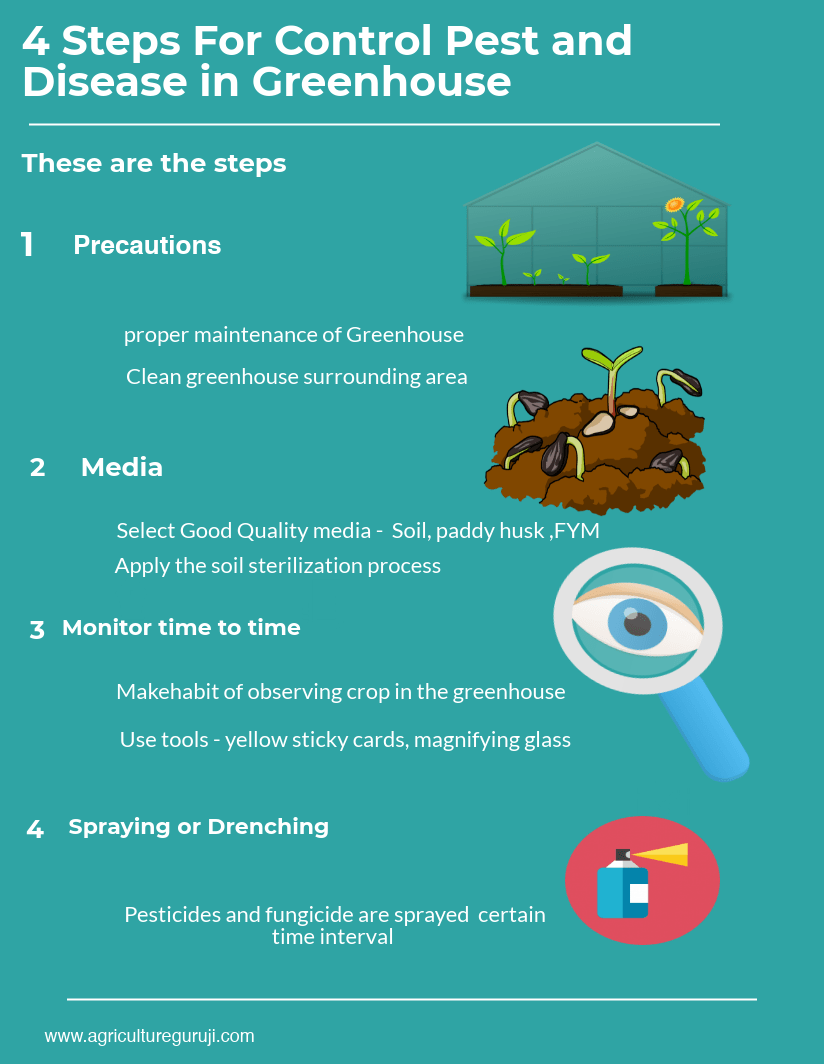Tips to Control Pest and Disease in Greenhouse
Before planting a crop in the Greenhouse, it is necessary to take care of the potential way of preventing such pests, insects, viruses & potential diseases. We must be aware of how to control Pest and Disease in the Greenhouse.
There are Ten–twelve types of insects, some viruses, bacteria, and many types of fungi are found to be annoying in the greenhouse crops.
Insects include Leaf Miner, Thrips, red mites, cyclamen mites, caterpillar, nematode, snail, mealy bugs. Most of the insect pests damage the crops by sucking juice, and the caterpillar, the snails, the larvae like insects, tender buds, flowers, and fruits eat them badly and cause damage.
Bacterial diseases spread in healthy plants due to juice-sucking insects. Viruses cause the growth of a plant, leaves become barked, and different colours, lines, circles are seen on them.
Crop Plant suddenly dies because of bacteria. The warm and damp environment in the polyhouse is nutritious for the growth of many types of fungi.
Such fungi attack crops on the leaves, rashes, roots and damage them in large quantity. Due to various types of pests and diseases, there was a decline in crop production; also, the quality of the flowers.
If you follow all four important tips to control Pest and Disease in Greenhouse, your greenhouse profit must increase.

1) Take These Precautions
There are many types of insects and fungi in the external environment. They are entered by air, open or torn sides, torn roofs, ceilings, open spaces, open doors, and clothes inside of the workers.
Many types of insects or other insects enter the greenhouse through the seedlings from outside. If the pests or diseases produced by such insects are brought in, then this insect & pest’s growth increases and spread to other healthy plants in a favorable environment.
While avoiding this risk, take the nursery’s seedlings, which is suitable for taking care of it, without taking them inside the greenhouse, and keeping it aside, take the preventive spray. If there is a weed in the greenhouse area, it is more likely that there are many types of pests and fungi.
After getting wind or getting a chance, the insects of pests or fungi enter the greenhouse from these weeds. For this, the surrounding area of the greenhouse needs to be weed-free and clean.
Many garbage collections in the greenhouse, eg. It is used to throw out old leaves, broken branches, thrown mounds, buds, bud blossoms, etc., near the greenhouse.
There is a possibility of this kind of garbage can grow on it, and it is possible to enter the greenhouse. Therefore, make such a habit of disposal of such wastes away from the greenhouse. If the curtain of the greenhouse is broken, then correct it immediately.
Probably have to sit tightly locked in the inside of the curtains. If the wind is strong, then the curtains of that direction should be covered. While entering the greenhouse, possibly separate, use clean clothes. Go inside the back door immediately after coming in or out.
Read more about Gerbera cultivation in polyhouse
2) Taking Care of the Media
Preparation to prevent access to pests and diseases in the greenhouse starts with selecting the medium to increase the crop. Most of the components are extracted from the soil, sand, manure, paddy husk, etc., to make the medium available.
Many types of fungi and nematodes can be imported into the greenhouse from the soil. First of all, choose the source of such factors carefully. They should also maintain their quality as usual. Farmyard Manure must be old, well-rotten, and paddy husk you should bring it fresh.
If all the ingredients needed for mixing the mixture are in place, mix them in the right quantity, spread them in the greenhouse, and apply the soil sterilization process. By this sterilization process, the medium can be free from pests, diseases, and weeds; But it does not always mean free from pests, diseases, and weeds.
Take Special care When weeds are growing, they compete with the main crops for all needs and home for many insects and pathogens.
Since only the main crop is being sprayed, the insects that fly on it easily move on the weeds and reduce the medicines’ effects that they will move back. To prevent this, weeding should be done to remove all the weeds grown in the greenhouse.
3) Monitor Time to Time
If the insect and pathogens are found early in the greenhouse, they can prevent their spread by taking immediate action. For this, apply the habit of observing crop in the greenhouse.
Ask experts to get information about pests or diseases found on cropped plants, to detect insects, or to detect symptoms of diseases.
Focus more on certain types of greenhouse place such as crop at the greenhouse corner, a crop near the door. Use yellow, sticky cards and a magnifying glass to check if there are insects in the greenhouse.
4) Spraying & Drenching – Pest and Disease Control in Greenhouse

To control the pests and diseases in the greenhouse, there are generally two ways to take measures.
There is careful monitoring of the crop every day while growing, and where there is a sense of pest & disease, by spraying or drenching on the infected & surrounding crop.
In other measures, the pesticides and fungicide are sprayed in greenhouses at specific time intervals due to insect pests, diseases, or not as precautions.




Very good article thank for sharing
Thanks, Ramraj
Pretty! This was a really wonderful post. Thanks for providing this info.
I really can’t believe how great this site is. Keep up the good work. I’m going to tell all my friends about this place.
My aunt has a green house. I will share this to her. I think that she will love this tips. Thanks for sharing this.
Thanks, Jeremy
Excellent work sr..Salute to you for providing the informatiin about the crops..
Thanks, Manju
Thanks Amar…..for your excellent article!!
Thanks, Bimod
Sir this mohan from tamilnadu
I am biggnier of poly house how to contect u sir this mohan
Thank you for comment, please contact on 8788462787
Hi Amar, very nicely presented. Thanks for sharing. Jenita Thinakaran
Thank you Jenita